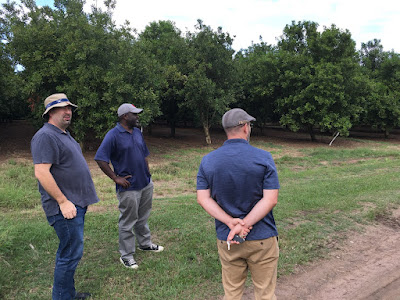 |
| Eswatini macadamia and pecan |
They are only about a half hour drive away in a very similar environment and fund their college with 90 acres of macadamias.
Macadamia production in southern Africa is expanding rapidly because it is highly profitable, but the plantations take many years to start producing enough to even start to break even.
These trees were planted in 2001, after a wildfire killed the first trees planted in '97.
Other blocks are younger as they planted for several years.
The nuts are collected at least weekly by hand.
The bags of collected nuts are weighed and put through a de-huller the same day to keep them from heating up.
Any hulls that remain are sent through again and any debris or damaged nuts are removed by hand.
Only clean nuts with intact shells go on to the drier.
warm air is forced through the bottom to the top of 8 or 10 of these large bins until they are at the right moisture level.
Then they are moved to the cool room until there is a truck load to take to South Africa for shelling.
Macadamias require much labor, providing local employment.
Some citizens of Eswatini go to South Africa for work.
These bags each weigh a bit over a ton.
Macadamia field in the background.
A bonus sighting for Cory - the source of one of his favorite pie desserts, with quality close to macadamia - pecan!
Pecan nuts were dropping from some of the 4 trees so Cory asked for a few to sample and to plant at the Wesleyan College.
We also learned about their organic chickens raised in a "tractor" (mobile pen) that reduced the feed cost and lowered losses from disease.
They grow gardens and chickens first for their cafeteria and extra is sold.
We toured the library and learned about some on-line study resources.










No comments:
Post a Comment